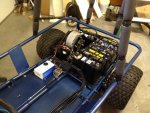techfab
New member
Hey All,
I have posted for specific advice in a few different threads on this site and received great feedback and am hoping I can get a little more.
My son and I are building a stretched version of the Spidercarts Recluse that both he and I will ride. We are going electric (in part because we live in California and my hippie neighbors would frown on anything but). I want it to be powerful enough to be fun for both of us now and for him to be able to grow into higher performance (by adding battery or adjusting throttle throw). I knew electric would be more expensive; but, I am shocked at how much more when you move past 1000W.
Anyway, I have learned a lot on the subject here and have done a lot of internet shopping over the last several weeks and keep coming back to the same motor/controller combo.
I am considering this motor:
http://www.ebay.com/itm/Manta-2-10-...tek-MT-Pattern-Permanent-Magnet-/301067430388
and this Kelly controller:
http://kellycontroller.com/kdz4820024v-48v200aseriespm-p-951.html
From the research I have done, it seems the motor is a re-manufactured version of the discontinued Briggs and Straton Etek motor. I can get it cheaper than listed. I haven't pulled the trigger since I can't find much feedback on the motor and it seems like it is modded by a mom and pop shop here in CA. Also, no warranty; so it seems a bit sketchy; but, based on my research, it seems to provides a lot of bang for the buck/size if it performs as advertised.
My questions:
Does anyone have any knowledge of this motor?
How do the specs look to y'all?
Do you see an issues with the motor/controller combo.
I plan to run it at 36v. I will obviously need some beefy AH.
I have posted for specific advice in a few different threads on this site and received great feedback and am hoping I can get a little more.
My son and I are building a stretched version of the Spidercarts Recluse that both he and I will ride. We are going electric (in part because we live in California and my hippie neighbors would frown on anything but). I want it to be powerful enough to be fun for both of us now and for him to be able to grow into higher performance (by adding battery or adjusting throttle throw). I knew electric would be more expensive; but, I am shocked at how much more when you move past 1000W.
Anyway, I have learned a lot on the subject here and have done a lot of internet shopping over the last several weeks and keep coming back to the same motor/controller combo.
I am considering this motor:
http://www.ebay.com/itm/Manta-2-10-...tek-MT-Pattern-Permanent-Magnet-/301067430388
and this Kelly controller:
http://kellycontroller.com/kdz4820024v-48v200aseriespm-p-951.html
From the research I have done, it seems the motor is a re-manufactured version of the discontinued Briggs and Straton Etek motor. I can get it cheaper than listed. I haven't pulled the trigger since I can't find much feedback on the motor and it seems like it is modded by a mom and pop shop here in CA. Also, no warranty; so it seems a bit sketchy; but, based on my research, it seems to provides a lot of bang for the buck/size if it performs as advertised.
My questions:
Does anyone have any knowledge of this motor?
How do the specs look to y'all?
Do you see an issues with the motor/controller combo.
I plan to run it at 36v. I will obviously need some beefy AH.

